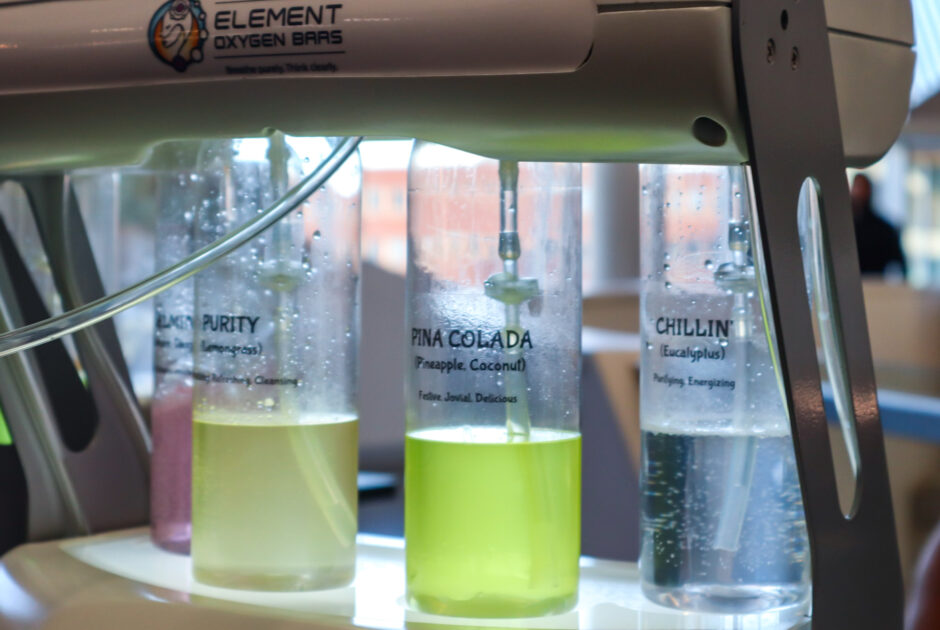Climate Zone: Living wall comes with environmental benefits

The Ottawa campus of Algonquin College is filled with interesting art and architecture but one of its most fascinating attractions is its vibrant bio wall.
Filled with a variety of different plant species, the wall is a beautiful attraction as well as an energy-efficient resource for the school.
Located in the Algonquin Centre for Construction Excellence, the green wall has been through many health challenges and repairs in its 12 years of life. The story of how the plants grow and survive along the living wall and what it really takes to care for it will give you a new perspective the next time you see it on campus.
What is the bio wall and what does it do?
Ascending 22 meters, all floors of the ACCE building get a view of the lush greenery. Beyond its aesthetic appeal and relaxing ambiance, the plant-filled wall has numerous benefits for the school environment.
“It cleans the air, removing volatile organic compounds as well as exchanging CO2 for O2,” said Amanda Barr, the coordinator of grounds maintenance and operations. “It also humidifies the air. Both of these lead to better air quality and the well-being of people who regularly use this space.”
How is it planted?
“Planting is a longer process than simply putting plants that we purchase on the wall,” said Barr. “All the plants on the wall must be bare-rooted and then acclimatized to a hydroponic system in order to be planted in the living wall.”
Bare rooting is a long and meticulous process taken on by the Algonquin grounds team who remove all the soil from the plant’s roots and then wash them to keep the plants’ roots from rotting.
Being a hydroponic system means the plants grow without soil. The team makes the hydroponic units that help plants develop stronger roots aiding their survival of the hydroponic system.
During this process the team monitors the plants to decipher which plants are capable of surviving and making space for new growth.
After the plants have acclimatized to the hydroponic units, the team plants them on the wall. “There are existing ‘pockets’ all over the material in the wall,” Barr explained. “We test each one before placing a plant inside to ensure that there is ample water available and then simply stick the plant inside and make sure it is able to stand upright and support itself.”
Overcoming Struggles
A living feature brings many hardships when it comes to maintenance. When the wall was first installed in 2011 many of the plants died because of the cold air coming in from the nearby exit.
After tackling that issue there were still more challenges to be faced. “We have since also dealt with excessive salt build up in the water, which was killing some plants and discolouring others,” said Barr. “Though we were able to solve each of these issues and come out on the other side with more information to ensure our wall can remain healthy for the long run.”
Another issue was during the pandemic when the aerial lift used for maintenance was inaccessible because it was sent away to be serviced. During this time many plants died and once the lift was returned to campus, they were able to fix it up.
“They removed all the dead material and replanted with new and then we had a great base to keep building from,” she said.
Maintenance
Since being back in full bloom since the pandemic, the wall has been in great condition featuring a variety of luscious green plants. Thanks to the grounds team the wall is cared for and maintained to keep thriving.
The long maintenance checklist includes water changes every three weeks, fertilization, cleaning leaves and removing the dead ones.
Not only does the team care for the plants but also the wall and its surroundings, ensuring the plants get the resources they need. Driplines, wall material and plant pocket inspections happen twice a month. The team also releases insects that are safe for the benefit of plant health and environment.
Current Condition
Living in a city environment doesn’t regularly showcase a clean and green environment. Seeing healthy greenery on campus can be refreshing, and many people aren’t aware of the benefits it brings to the environment.
“Plants are amazing at adapting to new environments, and people have been manipulating plants to grow in unique and interesting ways for a long time,” said Barr. “It just seems like a natural step for us to have taken to find technologies that allow us to effectively grow plants in a vertical wall for all the benefits they bring.”








